Côte d'Ivoire designates five new coastal Ramsar sites

The Ramsar Secretariat is pleased to announce that Côte d'Ivoire has just designated five new sites for the List of Wetlands of International Importance, effective as of 18 October 2005: Complexe Sassandra-Dagbego, Fresco, Grand Bassam, Iles Ehotilé-Essouman, and N'Ganda N'Ganda. This significant achievement has been made possible with funds from the Swiss government, under the Swiss Grant for Africa programme, and with the support of Ramsar. The country's six sites now add up to an area of 127,344 hectares and include a large extent of mangroves, a wetland type which has been identified as being under-represented in the Ramsar List and which should be prioritized in the designation process.
The sites are important from both a biological and socio-cultural point of view. They support a number of endangered, often charismatic species, such as the chimpanzee, forest elephant, pygmy hippo, crocodile species, and manatees; they are an important nesting ground for up to five species of turtles (green, hawksbill, olive ridley, leatherback and loggerhead); and they are also important breeding, resting or feeding grounds for different waterbird species.
At the cultural level, both the Grand Bassam and the Complexe Sassandra-Dagbego sites have old colonial cities, with an architectural and historical interest for the relatively numerous tourists who visit the sites from overseas and within the country. The importance of these sites for the local people is also very high, in terms of the natural resources that they provide (fish, reeds and wood for construction, plants for medicinal purposes, game meat, etc.), but also for religious and traditional reasons, as ceremonies take place there. Furthermore, some of the people, like the Ehotilé, believe they are the children of the lagoon of the same name by which they live. Although most of the sites are relatively well-preserved, a number of growing impacts from threats, including natural resources over-exploitation, oil exploration, reduced flows due to upstream dams and indiscriminate development, loom in the future. It is important that now that the designations have been made, the country profits from the momentum to produce and implement management plans (some have already been started) for these sites, to ensure their wise use into the future. We would like to congratulate Côte d'Ivoire again for having increased its number of Ramsar sites, after nine years since its first site was designated! We are also grateful to the Federal Government of Switzerland for its continuous support to Africa countries under the Swiss Grant for Africa.
Lucia Scodanibbio
Assistant Advisor for Africa
Complexe Sassandra - Dagbego. 18/10/05; Bas-Sassandra; 10,551 ha; 004°58'N 006°02'W.
Situated at the estuary of the Sassandra River, one of Côte d'Ivoire's biggest rivers, but also includeing some temporary estuaries, brackish marshes, freshwater swamp forests, alluvial forests, lagoons and mangroves. The site is rare in terms of the co-existence of the three mangrove types: Rhizophora racemosa (red mangrove), Avicennia germinans (white mangrove), and Conocarpus erectus (grey mangrove), which constitute the best-preserved stands in the country. The site hosts species ranging from primates to reptiles, tortoises and sea turtles, some of the great mammals, bats and more than 208 species of birds, especially waterfowl including herons and gulls. Fishing and tourism (aimed at beach and water sports, as well as at the historical colonial town of Sassandra) are the main activities, followed by livestock raising, wood collection and agriculture. The zone surrounding the site has a total population of 130,402 inhabitants. The main threats to the area include mammal and bird hunting, over-fishing and pollution from untreated waste from the urban areas. The Buyo dam upstream has also affected the water level in the wetland. Ramsar site no. 1581.
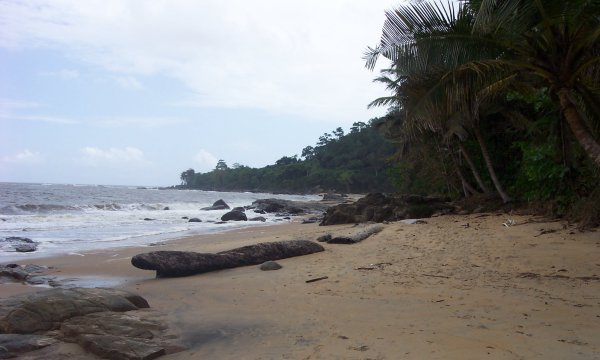
Fresco.18/10/05; Sud-Bandama; 15,507 ha; 05°07'N 005°36'W.
A coastal area demarcating the two different types of coastline in the country: west of Fresco the coastline is rocky, with cliffs alternating with beaches; east of the site, sandy beaches and dunes separate lagoons from the Atlantic, and the site includes both types of landscapes. It is an important nesting ground for turtle species like the loggerhead, leatherback, olive ridley and green turtles. It also hosts a number of endangered species like the manatee, forest and Nile crocodiles, the pygmy hippopotamus and several bird species. Some of these are migratory birds which have their nesting, feeding and/or resting grounds at the site: among them are Phalacrocorax africanus, Ardea purpurea, Nycticorax nycticorax and Butiroides striatus. The wetland maintains the area's hydrological balance by attenuating evaporation and recharging the groundwater level. On the social side, 15,000 people live around the wetland and local communities utilize 198 species of plants for alimentation, construction, firewood needs and other uses. Fishing, agriculture, shell collection, hunting and spiritual ceremonies also take place. Part of the site, at Port Gauthier, is a protected forest. An environmental education centre has been present since 2001. Ramsar site no. 1582.
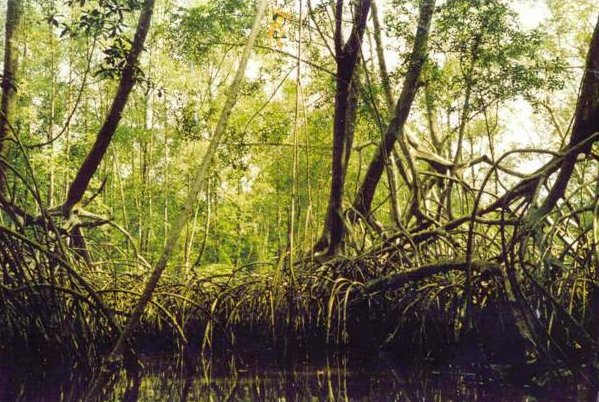
Grand Bassam. 18/10/05; Sud-Comoé; 40,210 ha; 05°21'N 003°46'W.
A mosaic of ecosystems near the estuary of the Comoé River providing refuge for different, often endangered species: the mangroves are an important habitat for primates such as the chimpanzee, the lesser white-nosed monkey, and the sooty mangabey, as well as a spawning and nursery site for different mollusks, fish and crustaceans. Forests, swamps and coastal savannas act as a refuge for elephants, otters, reptiles, leopards and crocodiles in an otherwise developed area. Many birds, including Anhinga rufa, Tigriornis leucolopha, Scotopelia peli and Ardea goliath, use the area as a nesting and breeding ground. Although artisanal fishing is the main activity carried out, tourism is also noteworthy, as Grand Bassam was the country's old colonial capital. The area is thus very significant from a cultural and historical point of view, with the local handcrafts the most creative and renowned in the country. The main threat includes invasive plant species like water hyacinth and Salvinia molesta, while outside the site sand extraction, over-exploitation of natural resources, and the discovery of oil pose growing threats. A strategy for sustainable management is being planned by the National Wetlands Committee (CONARAMS), while village commissions are responsible for natural resources management. Ramsar site no. 1583.
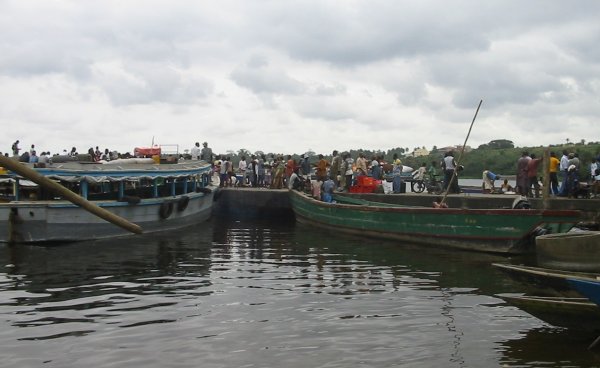
Îles Ehotilé - Essouman. 18/10/05; Sud-Comoé; 27,274 ha; 05°07'N 003°12'W. Includes National Park.
A group of nine islands situated in a lagoon separated from the sea by a string of sand dunes. The site is very important for aquatic fauna as it provides a spawning and nursery ground for a number of fish like Tilapia spp, Elops lacerta and Albula vulpes, for oysters like Crassostrea gasar, gastropods, prawns and crabs. The manatee, the spotted-necked otter and the African clawless otter also benefit from the aquatic environment. Numerous waterbirds reproduce at the site. The site also plays an important role in recharging groundwater levels, stabilizing the shoreline, attenuating wave action, and regulating the exchange of nutrients between the sea and the lagoon. The Ehotilé islands have been a national park since 1974, following the initiative of the local communities: no exploitation of this part of the site beyond tourism can occur, and in the rest of the site fishing is the main activity. The largest palm plantation in the world (11,000 ha) lies outside the site at Ehania. The cultural importance of the area is high, due to the presence of underwater ancestral cemeteries. Different scientific and educational projects have taken place at the site, including by local universities and WWF and Wetlands International. A management plan exists, but still needs to be implemented. Ramsar site no. 1584.
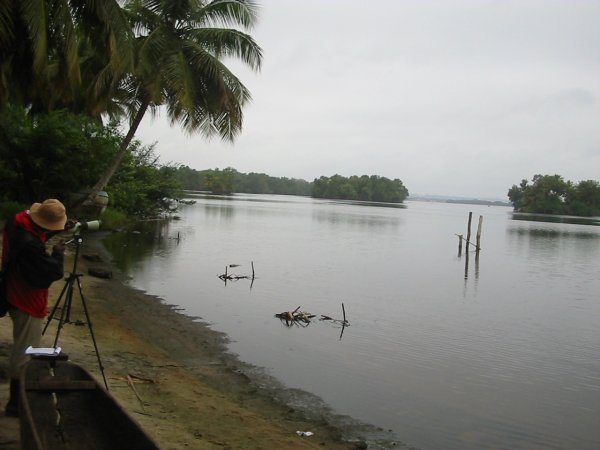
N'Ganda N'Ganda. 18/10/05; Sud-Comoé; 14,402 ha; 05°10'N 003°24'W.
A complex of relatively well-conserved forests, coastal savanna, mangroves and temporary and permanent pools. Numerous of the plant species present, such as Uapaca paludosa, Raphia hookeri, Rhizophora racemosa and Mitragyna ciliata, form important habitats for both terrestrial and aquatic species. Many birds like the Naked-faced and Hairy-breasted Barbets, the African grey parrot and the narrow-tailed starling, are granivorous or frugivorus and contribute to the dispersal and maintenance of several euphorb and other plant species in the area. The site plays an important role in the hydrological balance of the area, controlling floods, attenuating evaporation and recharging groundwater levels. The site is also significant from a cultural point of view as its inhabitants, the Ehotilé, believe that they are the children of the lagoon and that they originally lived at the bottom of the water and emerged out of curiosity about the terrestrial world. Local people collect many plants for medicinal and building purposes, hunt game meat, and fish in the site. The large-scale pineapple, oil-palm, rubber tree and coconut palm plantations outside the site pose one of the main threats due to pollution and habitat destruction. The National Wetlands Committee, together with the site managers, is working on the formulation of a management plan and conservation programme for the site. Ramsar site no. 1585.
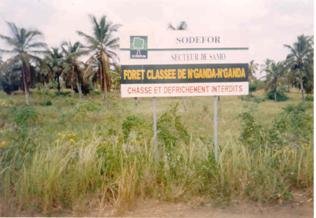
Updated description
Parc national d'Azagny. 27/02/96; Lagunes; 19,400 ha; 05º12'N 004º53'W. National Park.
A low plateau consisting of coastal and lagoon ecosystems of forest, savanna, swamp and mangroves, located in Cote d'Ivoire's lagoon region. Several large mammal species found here are endangered, vulnerable, rare or endemic, having benefited from the protection this site has afforded them since 1960. Species present include the forest elephant, the dwarf crocodile, four turtle species and several primates which occupy the park's islands. The diverse birdlife includes numerous migratory species and large concentrations of several heron species. The swampy depressions and mangroves are important spawning and nursery sites for diverse fish species, in addition to playing a role in flood control and sediment trapping. In the site only tourism, research, education and cultural/ spiritual activities are allowed, while outside it subsistence and commercial farming (coffee, cacao, rubber, oil palm, coconut palm), fishing, wood exploitation (for construction and energy), and a conservation education programme are the main activities. Poaching, bush-fires, and invasive species are the main threats to the site. A management plan exists since 1983, but it is only since the creation of the Ivorian Office of Parks and Reserves in 2004 that it has been updated and its implementation has started. Ramsar site no. 790.
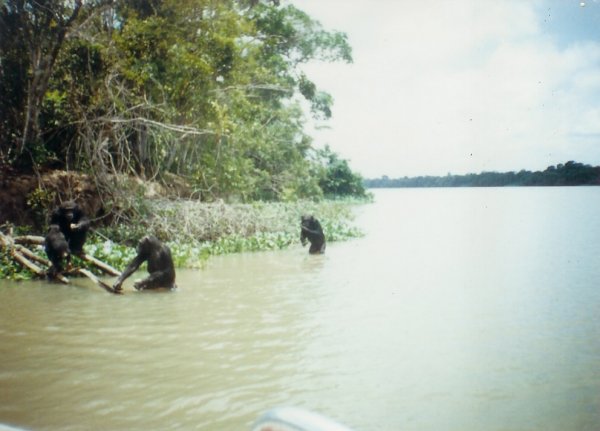
L'ile aux chimpanzes, Azagny